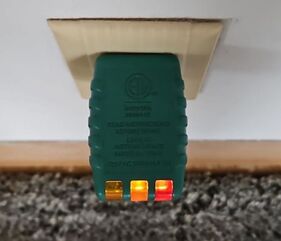|
When inspecting a home that appears to have had electrical work done by a non-professional (not a licensed electrician), I often find receptacles that have a condition called “reversed polarity”. Reversed polarity happens when a receptacle is wired in reverse. The hot and neutral wires get connected to the wrong terminal screw on the receptacle or reversed somewhere along the circuit upstream. Reversed polarity is a shock hazard and can damage the equipment plugged into the receptacle. A little background information on hot and neutral wires…
There are two wires that carry electricity to a receptacle. One of these wires is white and is referred to as the neutral wire. It is always connected to the earth so it is called a grounded conductor. The other wire is usually black or red and referred to as the hot wire. It is not connected to the earth and is not grounded. If you touch the conductor on a hot wire, you complete a circuit because of your contact with the earth and you will get shocked. In a standard circuit, the electricity will flow from the hot wire to the neutral wire. But in reversed polarity, the electricity will flow from the neutral to the hot wire. This can create a shock hazard for multiple reasons, including:
How can you tell if a receptacle has reversed polarity? I use one of these inexpensive testers that you can purchase at a home improvement store. The lights illuminate depending on how the receptacle is wired. Reversed polarity is generally a straightforward, easy repair. Sometimes the wires just need to be switched around at the receptacle and sometimes the electrician is going to need to trace the wires back further in the circuit to make the fix. It is important that receptacles with reversed polarity are addressed by a licensed electrician. Comments are closed.
|
Jill HaukI am a home inspector and a lover of old houses, dogs and mountains. Archives
November 2023
|
|
Jill Hauk Home Inspections, LLC
1000 Giles Street, Stoughton, WI 53589 (608) 957-5866 [email protected] Home Inspector in Madison, Stoughton, DeForest, Waunakee, Sun Prairie, Cross Plains, Middleton, Monona, Cottage Grove, Verona, Fitchburg, McFarland, Mount Horeb, Brooklyn, Janesville, Evansville, Oregon, Edgerton, Fort Atkinson, Jefferson, Lake Mills, Cambridge, Windsor, Johnson Creek and everywhere in between
|
Professional Affiliations
|
Copyright 2023 Jill Hauk Home Inspections, LLC



